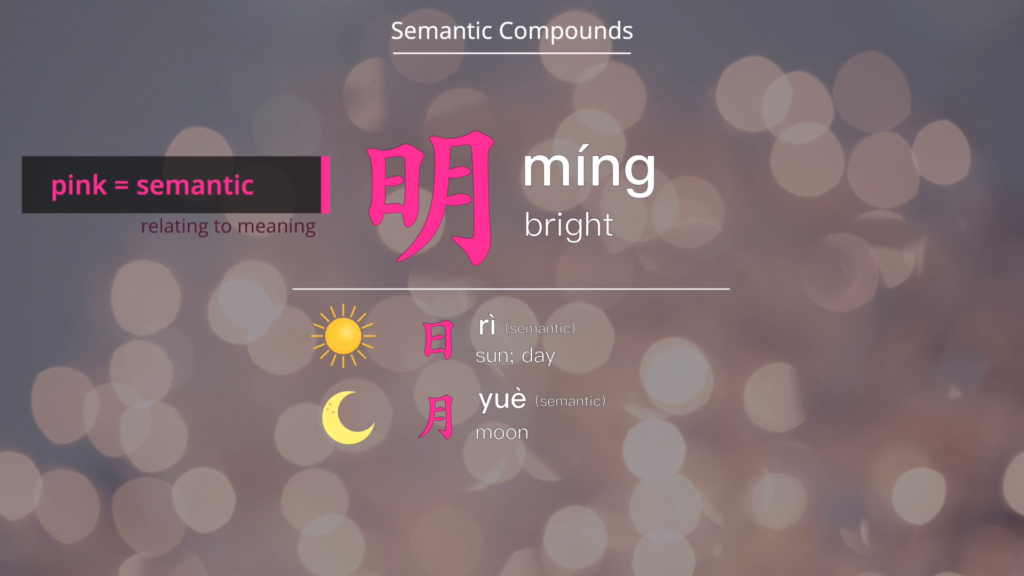Most flashcard apps are good at helping you review, using algorithms to help you optimize your efforts to remember what you have already learned. Few flashcard apps do well when it comes to learning new things in the first place, though. The result is that many students use mindless repetition to try to hammer in new characters and words. Spaced repetition is great for maintaining knowledge, but it’s not very good at encoding complex information in the first place.
One problem with simply repeating something over and over is that it doesn’t necessarily bring understanding, and research into learning in general shows that understanding has a big impact on memory. This is the difference between looking at a Chinese character and seeing a bunch of arbitrary strokes, and looking at the same character and seeing functional components. While you can memorize a jumble of strokes, it’s certainly harder than combining larger chunks that are combined in a meaningful way.
Building blocks and functional components

Most students are aware of the fact components can represent meaning in Chinese characters. For example, it should come as no surprise that the character 明 (míng) “bright” is composed of 日 (rì) “sun” and 月 (yuè) “moon”, and that both those components contribute to the meaning of the whole character (two bright objects being used to represent the concept of “bright”). If you weren’t aware of this, you would probably have figured it out soon!
Fewer students realize that combinations of two semantic (meaning) components like that are actually rare and that many components are not included because of what they mean at all. For example, in the character, 妈 (mǎ) “mother”, consisting of 女 (nǚ) “woman” and 马 (mǎ) “horse”, what does “horse” have to do with “mother”? Did the ancient Chinese regard mothers as female horses? No, they didn’t. Instead, the character 马 (mǎ) “horse” is included because of the way it’s pronounced, not because of what it means (except for the tone, it’s pronounced the same as 妈 (mǎ) “mother”. Without this kind of insight, it’s impossible to understand Chinese characters, which makes them harder to learn and remember.

The character course is now available in Skritter
As part of our ongoing effort to make Skritter the best possible app for learning Chinese vocabulary, we have created a character course that distills all the essential insights you need to make sense of Chinese characters and thereby make them easier to learn! Here’s the first episode, which introduces the course itself:
In 16 concise episodes (5-6 minutes), we teach you everything you need to know about characters, from very basic things like stroke order and pictographs, to more complex concepts like phono-semantic characters and character corruption. Here’s a list of all the episodes in the course:
- Introduction
- Pictographs
- More Pictographs
- Simple Ideographs
- Stroke Order
- Semantic Compounds
- Character Composition
- Shape-Shifting Characters
- Complex Pictographs
- Phono-Semantic Compounds
- More Phono-Semantic Compounds
- Even More Phono-Semantic Compounds
- Character Corruption and Convergent Forms
- The Most Common Chinese Characters
- Word Formation
- Chinese Character Variation
The Skritter Chinese Character Course: For beginners and more advanced students
Each section has a video that presents the content, along with a number of characters and components to study for that episode. When you’ve worked your way through the whole course, you will know roughly 150 high-frequency characters and character components, along with everything you need to know to learn as many characters as you want!
This means that the course does not assume that you know anything at all about Chinese characters.
- For complete beginners, this is great, because you will not find this type of information in the average textbook and probably not even in many university courses either.
- For more advanced students, this is also great, because you can make sure you haven’t missed anything important. You will of course have fewer characters to learn, maybe no new characters, but learning more about how characters work will help you learn any new character you encounter, not just those covered in the course!


